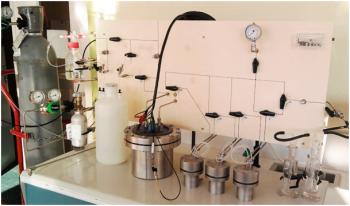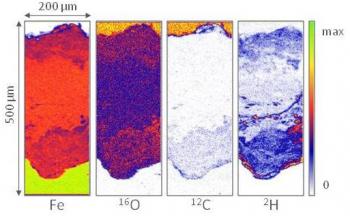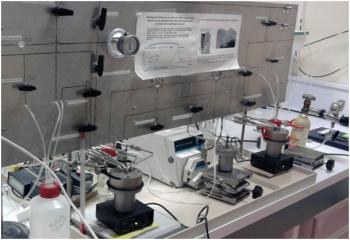

The LAPA developed for re-corroding archaeological systems, originals setups, allowing to continue century old corrosion process in the lab and under labeled environments.
One way to get reliable knowledge about long term corrosion is to perform re-corrosion experiments. From natural sites, known for their chemical stability for years, corroded samples are picked up and then submitted to experiments. Discrimination between the changes during laboratory tests and the previous alteration in the natural media is performed using stables isotopes. Deuterium (heavy water) and gaseous oxygen 18 are commonly used in these experiments.
Due to the cost of the labeled compounds and the long duration of the experiments, the experimental devices are designed with a special care. Vacuum and high pressure solutions are applied to achieve the most perfect tightness. Stainless steel is the main material used and sometimes materials with low oxygen permeability are selected. The philosophy of the experimental process is to remove any oxygen trace (gaseous or dissolved) before introducing labeled compounds.
Later modifications revelation implies isotopic sensitive analysis by the mean of the nuclear microprobe. Practically, nuclear reactions are induced by the light ion scanning beam and reaction product detection precisely locates the stable isotope.
•  Matériaux des nouvelles technologies pour l’énergie › Corrosion long terme de matériaux métalliques / Long term corrosion of multimaterials containing metals
Matériaux des nouvelles technologies pour l’énergie › Corrosion long terme de matériaux métalliques / Long term corrosion of multimaterials containing metals  Physique, chimie, nanosciences et matériaux autour des grands instruments
Physique, chimie, nanosciences et matériaux autour des grands instruments
•  Institut Rayonnement Matière de Saclay • UMR 3299 - Service Interdisciplinaire sur les Systèmes Moléculaires et les Matériaux
Institut Rayonnement Matière de Saclay • UMR 3299 - Service Interdisciplinaire sur les Systèmes Moléculaires et les Matériaux
• Laboratoire archéomatériaux et prévision de l'altération (LAPA)
• Laboratory re-corrosion experiments using stables isotopes in NIMBE/LAPA








